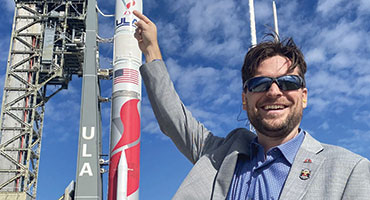John Thornton looks up at our nearest neighbor in space and sees a full moon of opportunity.
It has been more than half a century since a human being last touched down on the moon’s surface. But at the North Side-based space exploration company Astrobotic Technology, for whom Thornton serves as CEO, returning to the moon is seen as an attainable, and affordable, mission.
“The moon,” Thornton says, “is our launchpad. It’s the gateway to the solar system and ultimately the rest of the universe.”
Astrobotic’s goal of establishing an extended human presence on the moon is seen as a means of reducing the costs of further space exploration, potentially leading to more ambitious missions elsewhere. The moon’s materials could be a source for rocket fuel and breathable air, and extended time on the moon could lead to the development of new technologies.
“It’s the place that we’re going to go to learn to live off the land,” Thornton says. “If we’re ever going to get to Mars with humans, I think we’re going to need to learn to live and operate on the moon first.”
That’s why Astrobotic has created a 47,000-square-foot “Moon Base” complex that is the largest private facility in the world dedicated to lunar logistics. The company, which has more than 280 employees, has secured more than 60 contracts from NASA, the Department of Defense and commercial entities totaling more than $600 million to develop space technology that includes everything from lunar landers, rovers and power infrastructure networks to terrestrial rockets, rocket test beds and GPS-denied landing networks.
“This is about making a difference and making history,” Thornton says. “That’s the thing that unites us here at Astrobotic, where we are space nerds to the core.”
Though these “Astrobots,” as Astrobotic’s employees are called, have endured disappointment and daunting challenges, they continue their mission to reach the moon enthusiastically and undeterred.
The stars align
When the Apollo 11 became the first crewed spacecraft to land on the moon back in 1969, Pittsburgh played a crucial role.
A Steel City manufacturing firm called North American Rockwell developed and built the command module “Columbia,” which served as the living quarters for the three-person crew during most of the mission. The shock-absorbing legs of the lunar landing module “Eagle” were made by Pittsburgh-based aluminum supplier Alcoa. Neil Armstrong planted the flag using a pole designed by a Yinzer named Jack Kinzler. And even the cameras that broadcast the amazing event to 600 million people were provided by Pittsburgh-based Westinghouse.
It is fitting, then, that a Pittsburgh company is deeply involved in the present-day efforts to complete a lunar landing.
“We’re bringing it back,” Thornton says.
Astrobotic launched in 2007, when Carnegie Mellon professor Red Whittaker assembled a team with the intent of winning the Google Lunar X Prize, a competition aimed at landing a lunar rover on the moon and transmitting high-definition video and images. Whittaker tapped Thornton, who earned his masters in mechanical engineering at Carnegie Mellon that year, to be the chief engineer of a project that evolved into a business, with a concept lander called “Griffin” serving as the centerpiece.
“At the time, I had an offer to intern at a big aerospace company,” Thornton says. “The alternative was to take my moonshot.”
He opted to shoot for the moon. What Thornton, who would become president of the company in 2012 and CEO in 2019, didn’t know was how long it would take to get there.
“The first 10 years of the company, we really struggled,” he says. “We almost went under several times. When I took over about 11 or 12 years ago, there were just a couple other people working here, and I wasn’t even sure people were going to show up for work.”
A company like Astrobotic cannot survive without government funding. And while Astrobotic secured some financial assistance from NASA for various projects in its first decade of existence, convincing people that a small company from Pittsburgh could potentially lead America back to the moon and that the government should buy commercial services to go to the moon was difficult.
“It was a big, long campaign to get to that point,” Thornton says.
The breakthrough came in 2018, when NASA began its Commercial Lunar Payload Services (CLPS) initiative, in which the federal government agency contracts private companies to deliver science and technology payloads to the moon. The following year, Astrobotic secured a $79.5 million CLPS award for 28 payloads of lunar delivery, allowing the company to hire dozens of new employees and ramp up its mission.
“And we’re off to the races,” Thornton says.
But that race is crowded. And as the world saw early in 2024, it is complicated, too.
Out to launch
It took more than 16 years for Astrobotic to reach the point where it could launch a lunar lander into space. And it took about seven hours to determine that the launch was a failure.
The Peregrine lander took off on Jan. 8 of this year, carrying 20 payloads that ranged from miniature rovers to commemorative items (including a Kennywood token to represent Pittsburgh). But it encountered critical setbacks on its mission to the moon, suffering a severe issue with its onboard propulsion systems, leaving it without enough gas to make a soft touchdown on the moon.
“There was a valve that failed,” Thornton says. “The valve actually had some design challenges inside of it that led to the failure there. There was a threaded joint held by Loctite. We think that came loose, which changed the dynamic of the valve and let the helium through.”
Forced to shift course, Astrobotic directed the spacecraft to operate like a satellite, testing its onboard instruments and other systems. It then safely disposed of the vehicle by crashing it into Earth’s atmosphere at high speeds.
The failure of the Peregrine mission generated headlines worldwide and was seen as a blow to Astrobotic and NASA. But innovation is not a straight line. Lunar landers have a historical success rate of less than 50 percent.
Thornton, who had acknowledged Peregrine had been “headed into a gauntlet” as the very first CLPS mission, is viewing the setback through the lens of a learning opportunity.
“Sometimes you have to learn the hard way,” he says. “We have to keep in context what we are trying to do. We are trying to return to the moon at a fraction of the price that it would cost if you knocked on a big player like JPL’s [the NASA Jet Propulsion Laboratory] door or anyone else’s door. That’s the hardest part of the whole thing. It’s figuring out where to spend the money and the focus and where is good enough to get the mission done.”
The space industry continues to try to figure out that equation. A company could invest billions upon billions of dollars to try to get it right the first time and still be wrong. A company like Astrobotic is aiming for low costs in order to make recurring missions feasible and affordable.
“We would have had a really good shot to land if that valve hadn’t failed,” Thornton says. “This model is pretty close. It probably will work, given a little more time and more opportunities to succeed. I think that’s exciting for the industry and exciting for the nation.”
The nation has a lot of companies competing with Astrobotic in the race to space, and operating in Pittsburgh rather than a more established space hub in Houston creates additional challenges in securing funding and top talent.
“We’re the underdog,” Thornton says. “But we’re still fighting and still making headway. I think if we can get there and break through, we can create a sustainable long-term business that can be really good for the growth of the Pittsburgh region.”
Despite the challenges, Astrobotic is committed to the region.
“What I really like about Pittsburgh is the advantage that we have in the robotics industry,” Thornton says. “And I think that that helps us have an edge in space, because we typically can attract the local robotics talent and combine that with space experience and we can really push the bounds of what’s possible.”
Pushing the bounds of what is possible is at the heart of what Astrobotic is attempting to accomplish. And after the disappointment of what happened with Peregrine, the company is forging ahead with Griffin, which as of this writing did not have an official mission date but was being readied for launch.
“Peregrine has flown so Griffin may land,” the company wrote on its website. “Ad luna per aspera.”
That last phrase is the Star Trek motto, “To the stars through difficulty.” At Astrobotic, the importance of the opportunity outweighs the daunting nature of the difficulty.
“We’re persevering and pushing through,” Thornton says. “We’re going to continue fighting and making a name for ourselves in space.”


